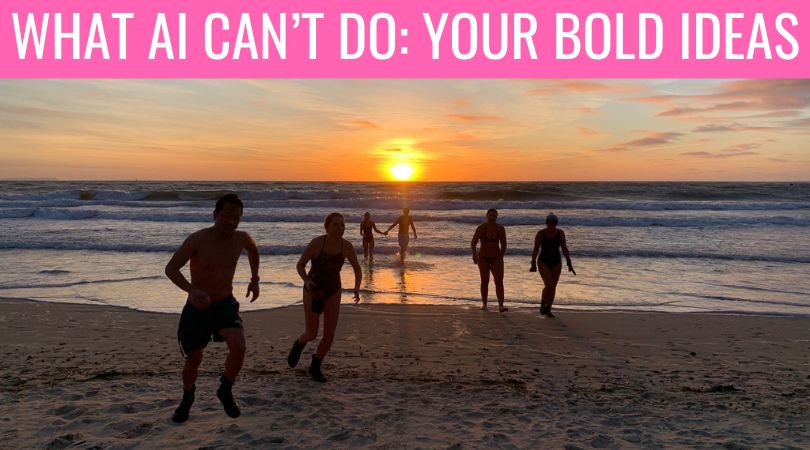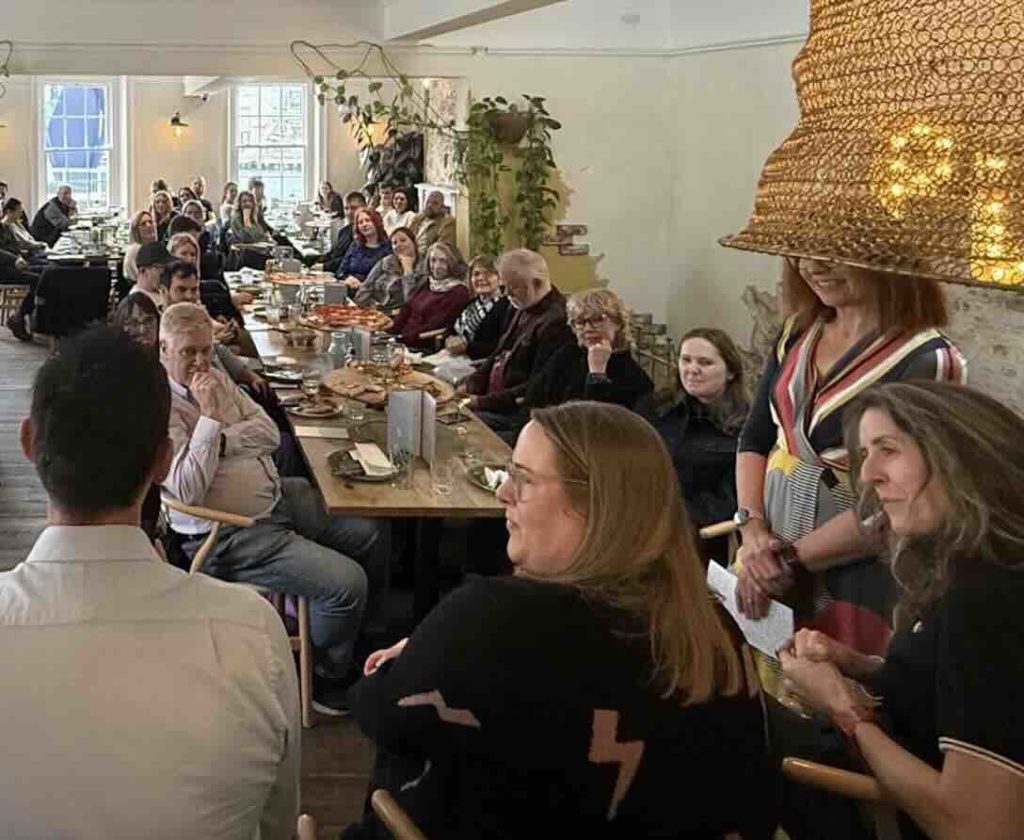Let’s learn and create together!
Book your placeThe Unexpected Source of Innovation: You

We can do the things that AI cannot touch and the experts miss.
When you feel connected to others in a shared space you can explore new ideas, develop insights and act on them. The ‘right way’ isn’t always the only perspective to consider.
When you know you feel supported, we can all contribute and bring new ideas to life. Having the freedom to experiment, try new things that are new (and nervous) and innvovate, can come from you as well as unexpected people and places.
The act of creation—whether through tangible projects or innovative ideas—helps personal and collective growth. In 2025, there is every reason to lean into creativity and experimentation to discover what’s truly possible.
What Makes It Easier To Experiment
When you feel supported, it takes the risk out of experimenting.
No one likes to step into a space when there is unfamiliarity, apart from your own willingness to do something new and exciting. I have tried this and if it doesn’t hit you on your pocket, it can blow your confidence.
When embarking on something entirely new without any groundwork, few people will show up when needed. If it doesn’t connect to a larger idea and remains isolated, it can leave you feeling disheartened.
For example, I have experienced events being cancelled before they were delivered because there wasn’t enough interest. Additionally, when leading workshops down a particular path, some participants left as it wasn’t suitable for them.
Experimenting was challenging because many people were unfamiliar with each other. Often, I found myself standing in front of a crowd as a stranger (particulalry if it was someone else’s audience). However, when you realise that you have an audience alongside you, it boosts your confidence in front of everyone. Today, the risk is reduced because people are part of a larger and more inclusive environment.
Trust that is already in place from others plays a huge factor when you want to push the needle.
People give up too soon, it’s not because of the novelty and quirk of the idea, it’s because people were not on the same side. When you know there are others with you, you don’t need permission from anyone, you find the new norm.
Often, the most valuable ideas come from people who see the world differently. Consider the Maker Movement, which emphasises grassroots creativity. Makers thrive on the belief that their perspectives matter and that they don’t need to wait for validation to create something impactful. As Dale Dougherty stated back in 2012, ‘The more we dive into something we didn’t know how to do before, whether by figuring it out on our own or reading an article or talking to a friend, the more interesting life becomes.’
Community As A Foundation For Innovation
Community can become a co-learning space where everyone benefits from collective knowledge, support, and encouragement.
What happens over time is that experimentation and doing something new doesn’t rest solely on the shoulders of the person who stepped forward first; it also involves others who feel a connection to the community.
In YATM, members don’t just consume content—they contribute, shape, and lead. This reflects the collaborative spirit we aim to achieve, where people exchange ideas, support each other, and innovate together.
In February, we are launching YATM Lunch Club, in London. It’s hosted by community members Catherine Turner and Jon Burkhart. Then we head to Poole where Anne Rutherford leads. I wanted to share this because it highlights how empowering others to take the lead can elevate the entire community. It encourages people to step out of their comfort zones and try things they haven’t done before, showcasing their bravery and willingness.
Unexpected Contributions
While social platforms and AI are helpful, the true power lies in human ingenuity and being unafraid to do things the way ‘it’s always been done.’
Tools are secondary to the creativity of people. Innovations often arise from unexpected sources: the person who has never spoken in front of an audience before, or the person who captivates others by being entertaining and engaging, despite never being chosen in the past.
The source of innovation is often where you least expect it.
How You Can Think About It & Push The Innovation Button
Here are practical ways to approach creativity and experimentation in 2025.
The key is to act with intention while remaining open to learning from the work you do.
Success comes not from perfection but from a willingness to engage with the unknown.
1. Work On What Can Pay Off
Concentrate on projects that align with your overall message or initiative. Ensure there is a clear connection between your work and your reputation.
When people can see that link, they’re more likely to engage and support your efforts.
To explore a new idea, my initial step was to interview marketers from around the world about their perspectives on content marketing from 2014 to 2016. This process became my way of learning. It’s important to trust your instincts; when you feel a connection, take action without waiting for permission.
For instance, the YATM Conference started in 2018 as an idea to bring people from the wider community together. By testing different formats, we learned what resonated most with attendees, it was being around each other. This is why we now have YATM Creator Day where the focus is connection and friendships made. Our willingness to experiment transformed an initial concept and a traditional conference format into a flagship event.
2. Accept That You Won’t Get the Results You Wished For
Sometimes your best ideas won’t land as expected or out of your control. That’s ok. In 2020, YATM tried to launch an in-person event in Bristol. A month later, COVID struck, and the idea had to be put on hold. While disappointing, the effort laid the groundwork for future projects.
Not every attempt will succeed, but each one builds experience and resilience. It’s the iterations you make that are important. You cultivate a culture where mistakes and experimentation are not only accepted but supports growth.
3. Timing Isn’t Everything
If you wait for the perfect moment, you’ll likely miss it.
Curiosity and the willingness to take action are much more important. Start small and iterate as you go. Back in 2020, we thought YATM’s Bristol event was perfectly timed (see above). However, it turned out not to be, but the effort put into it was still valuable. Seize the opportunity while the idea is still fresh.
4. Make a Worthy Go of It (You Can’t Give Up Too Soon)
Good ideas encounter resistance. Before giving up, it’s important to consider making adjustments or reassessing the situation.
YATM began quietly, but momentum really picked up when I personally reached out to subscribers. In 2016, when we started hosting live events, I contacted subscribers who I noticed were local to me and invited them to meet up to get to know each other better.
People who attend your events often become contributors, actively shaping the culture and direction of what you aim to develop.
Every idea goes through a phase of conflict, and you must decide whether it’s worth fighting for. If you find that you’re losing momentum, sometimes the best option is to take a pause.
Assess honestly when it’s time to tweak, persist, or walk away. Sometimes, stepping back is the most creative decision you can make.
5. Go Where The Risk Is Low
Rather than going all in on one big idea and delivery, it’s sensible to make gradual, manageable steps.
Test out formats before making the decision to scale up. For instance, if you want to deliver a big event for over 150 people, start small to build awareness and your own confidence. This initial event can serve as a testing ground for familiarising yourself with the structure and approach that works best for you.
Should it feel relaxed, or should it feel more direct and information-led?
What this allows is reducing risk and allows to you pivot and change if needed.
7. Know Where Your Strengths Are
Lean into what you’re naturally good at. If your strength is storytelling, find ways where narratives come together. If you’re great at building connections, host events or lead discussions.
When you work from your strengths, you create a solid foundation for your creativity to flow.
This approach feels much more comfortable than entering a space where you are completely inexperienced. While you will learn over time, it’s beneficial to begin with the skills you already possess.
Let’s Round-Up
If AI can produce perfectly crafted work, we need to embrace our willingness to try, even when we feel uncertain at times, and to iterate on our efforts. Failure and mistakes are not the focus; they are simply essential steps toward achieving better outcomes.
The real question isn’t whether you can create—it’s about what you will create next. The future belongs to those who are willing to experiment, adapt, and share their perspectives with others.
Take one bold step today—whether it’s a conversation or sharing an idea you’ve been sitting on. The act of doing will reveal what’s possible.
Listen to the audio deep dive on this article (via Notebook LM) here.
Build Your Community
A brand new programme from Mark Masters for businesses wanting to make that next growth step.
Find out moreYATM Club
Where non-conformist business owners come to work, learn and make friends. Click here

